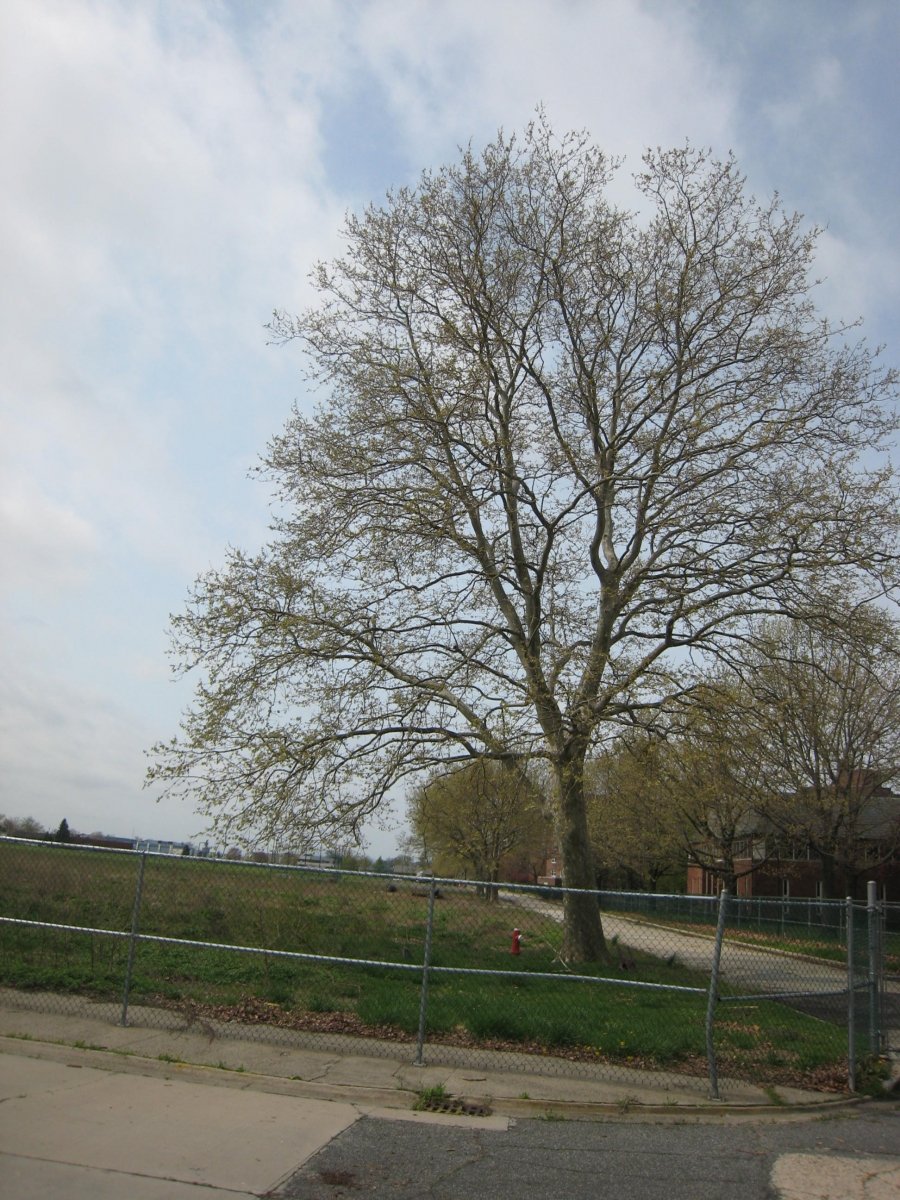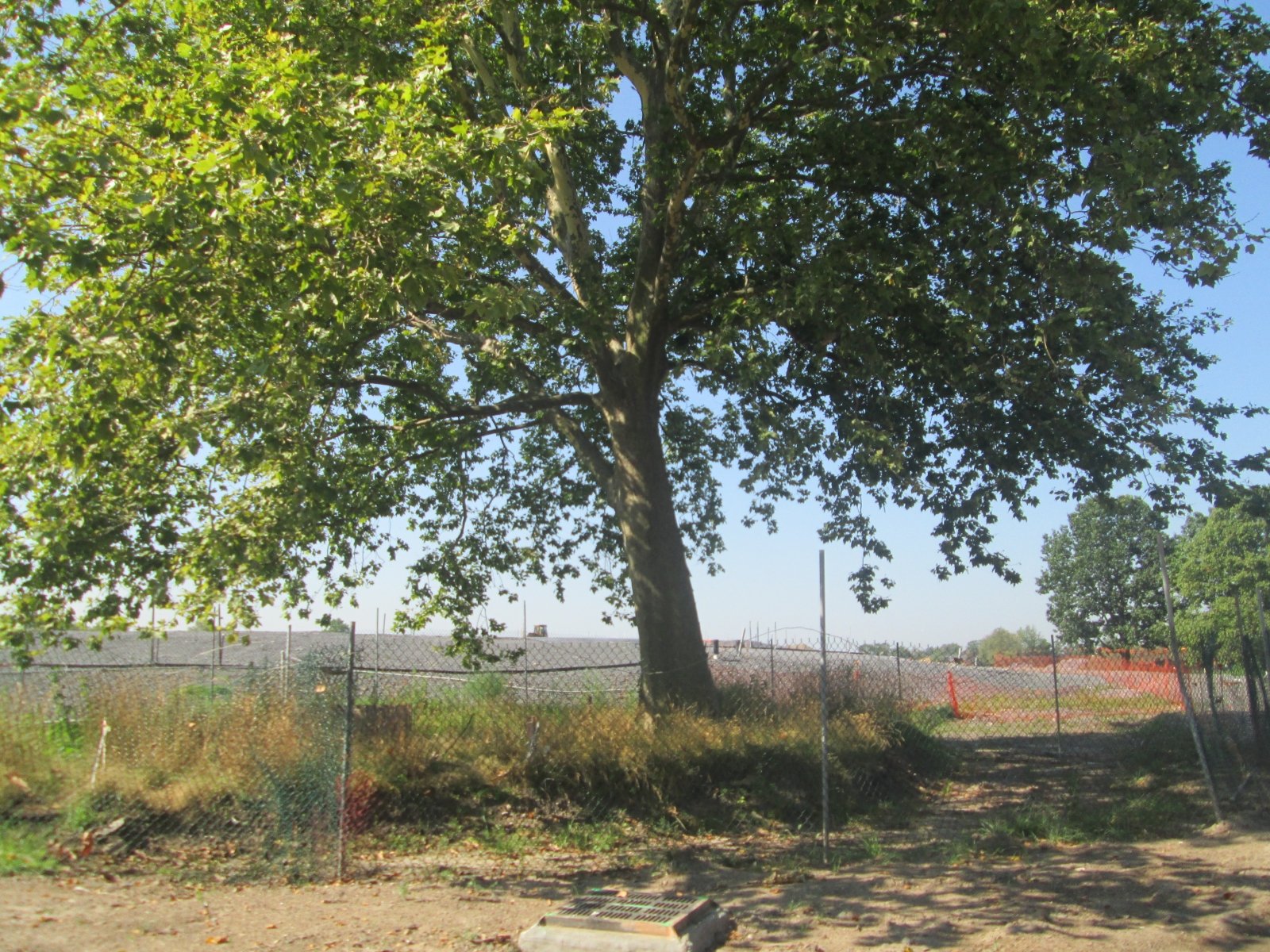
January 7, 2016
To Preserve and Protect: Working with Arborists
Certified arborists provide tree assessment reports and develop tree protection plans during the design process to ensure healthy environments for urban forests.
Tree 1199 post-construction and the newly planted landscape beyond, Governors Island, NYC.
Image courtesy of Mathews Nielsen
Our last post discussed the increasing formal integration of cyclists into streetscape design. Here we examine how arborists partner with landscape architects to ensure healthy environments for the trees that line our urban bike paths and enhance our public spaces.
As landscape architects we love trees! Be they pre-existing or newly planted, trees are often the backbone to a site design. Mature, statuesque trees add invaluable character to a place and are often a site’s greatest asset or attraction. Take for instance the Queens Giant, a tulip tree located in Alley Park Pond in Queens; it’s an estimated 350-450 years old, possibly the oldest living thing in New York City. A tree planted today wouldn’t reach this age until 2365! Landscape architecture involves a significant amount of long-term thinking and planning, so we recognize the importance of preserving and protecting existing trees for future generations. To make sure this happens throughout the construction process, we typically team with a certified arborist to provide a tree assessment report and develop a tree protection plan.

Pre-construction on Governors Island, tree number 1199, a 35-inch caliper London Plane Tree located between the historic Liggett Hall and the new landscape, was selected to be preserved.
Image courtesy of Mathews Nielsen
At the beginning of the design process, an arborist begins by reviewing the health of existing trees within a project boundary. This provides a baseline for pre-construction conditions, as well as informs the design team and owner if specific trees are structurally sound and healthy enough to survive a long construction period. A typical tree report begins by creating unique tags for each tree being evaluated and includes information like caliper size, dimensions for the crown width or dripline, and the critical structural root zones. It also provides a condition assessment that looks at the roots, trunk, and branching structure of the tree. Trees can then be identified to remain based on a variety of factors including size, aesthetics, proximity of root zones to new construction, and significant shading provided by canopy width. Once the report is provided, the design can then develop around a realistic base plan that includes areas of protection and areas of new planting. Because the majority of a tree’s most absorbing roots are in the top 24 inches of soil where water and oxygen are most available, existing ground elevations around protected trees must be maintained, when possible, as far out as the dripline. Because these criteria can affect a design, it’s essential to establish them at the beginning of the design process.

This diagram illustrates the canopy width, critical root zone, structural critical root zone, and diameter at breast height for a 25-inch caliper London Plane tree in Manhattan.
Image courtesy of Mathews Nielsen
Both the critical and structural critical root zones are key factors in developing an area of protection. The International Society of Arboriculture (ISA) defines the critical root zone as 1.5 feet for each inch of tree trunk diameter at breast height (DBH). In the event that a safety zone cannot be established at this distance, some arborists will also provide a structural critical root zone, which is much narrower than the critical root zone—sometimes as narrow as five times DBH—and is based on the actual location and growth pattern of the major roots. In urban conditions, where pavements and utilities can interfere with typical root growth, this can be a very useful investigation. Both the critical and structural critical root zones are used to define protection fence lines and limits of construction and excavation.

During construction, tree protection fencing is evident around tree 1199, Governors Island, NYC.
Image courtesy of Mathews Nielsen
After the existing trees are surveyed and inventoried, tree protection protocol is developed. These guidelines are concerned with compaction of soils around trees and excavation around existing tree roots. The protocol will typically provide recommendations for root pruning and ways to avoid compaction in the root zone. They will also establish a fenced-in area at each tree (based on the critical or structural critical root zone) within which no construction activity is permitted. This helps limit accidental damage to the tree trunk and vehicles driving over root zones. The soil within this area is typically protected by a three-inch layer of mulch. This is useful should any accidental spills take place in the critical root zone of a tree—if this happens, the mulch must be replaced immediately. All tree protection fencing should be in place before any work takes place on site. To further ensure compliance with their recommendations, arborists can monetize the value of individual trees so that an owner can be fairly compensated should anything happen to the tree during the construction process.
Unfortunately, trees cannot protect themselves. So the City of New York does what it can to protect our urban forest and only allows the removal of city trees—those located along our streets and in our parks—with permission of the New York City Department of Parks and Recreation. We even have laws that make it “illegal and punishable by law for citizens to remove, kill, or damage a street or park tree, whether intentionally or accidentally.” However, activities less overt than vandalism are sometimes just as lethal, such as a construction process that can bring serious damage to trees with impacts only seen years later. Bringing an arborist on at the beginning of the design process is essential in order to mitigate these potential damages.
Johanna Phelps, RLA, is a senior landscape architect at Mathews Nielsen Landscape Architects in New York City. Since receiving her MLA from the University of Pennsylvania in 2004, she has worked on urban design projects in Manhattan, Brooklyn, and Philadelphia, and multiple campuses including Brooklyn College, Haverford College, Rockefeller University, and the University of Pennsylvania. Johanna is interested in the co-evolution of urban spaces and their occupants.
This is one in a series of Metropolis blogs, written from within the practice by members of Mathews Nielsen Landscape Architects’ Green Team, which focuses on research as the groundswell of effective landscape design and implementation. Addressing the design challenges the Green Team encounters and how it resolves them, the series shares the team’s research in response to project constraints and questions that emerge, revealing their solutions. Along the way, the team also shares its knowledge about plants, geography, stormwater, sustainability, materials, and more.
Follow Mathews Nielsen Landscape Architects on Twitter at @mathewsnielsen and Instagram at mathewsnielsen.





